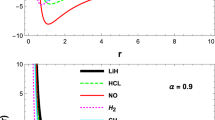Abstract
The identification of the phase space ofN classical identical particles with the equivalence class of points is of crucial importance for statistical mechanics. We show that the refined phase space leads to the correct statistical mechanics for an ideal gas; moreover, Gibbs's paradox is resolved and the Third Law of Thermodynamics is recovered. The presence of both induced and stimulated transitions is shown as a consequence of the identity of the particles. Other results are the ‘quantum’ contribution to the second virial coefficient and the Bose-Einstein condensation. Photon bunching and Hanbury Brown-Twiss effect are also seen to follow from the classical model. The only element of quantum theory involved is the notion of phase cells necessary to make the entropy dimensionless. Assuming the existence of the light quantum or the phonon hypothesis we could derive the Planck distribution law for blackbody radiation or the Debye formula for specific heats respectively.
Similar content being viewed by others
References
Bose, S. N. (1924).Zeitschrift für physik,26, 178.
Debye, P. (1912).Annalen der Physik,39, 789.
Einstein, A. (1925).Berliner Berichte, 3.
Einstein, A. (1909).Physikalische Zeitschrift,10, 185.
Gibbs, J. W. (1948).Collected Works, Vol. II. New Haven.
Hanbury Brown, R. and Twiss, R. Q. (1956).Nature (London),177, 27.
Hanbury Brown, R. and Twiss, R. Q. (1957a).Proceedings of the Royal Society (London),A242, 300.
Hanbury Brown, R. and Twiss, R. Q. (1957b).Proceedings of the Royal Society (London),A243, 291.
London, F. (1938).Physical Review,54, 947.
Nernst, W. (1906a).Nachrichten von der Gesellschaft der Wissenschaften zu Göttingen (Mathematisch-physikalische Klasse), Heft I.
Nernst, W. (1906b).Sitzungsberichte der Preussischen Akademie der Wissenschaften zu Berlin, V. 20, December 1906.
Nernst, W. (1918).Die theoretischen und Experimentellen Gundlagen des neven Warme-satzes. Halle.
Planck, M. (1900).Verkandlungen der Deutschen physikalischen Gesellschaft,ii, 237.
Planck, M. (1932).Theory of Heat. London, Originally published in German in 1906.
Uhlenbeck, G. E. and Gropper, L. (1932).Physical Review,41, 79.
Wolf, E., and Mandel, L. (1965).Review of Modern Physics,37, 231.
Author information
Authors and Affiliations
Rights and permissions
About this article
Cite this article
Sudarshan, E.C.G., Mehra, J. Classical statistical mechanics of identical particles and quantum effects. Int J Theor Phys 3, 245–253 (1970). https://doi.org/10.1007/BF00671006
Received:
Issue Date:
DOI: https://doi.org/10.1007/BF00671006




